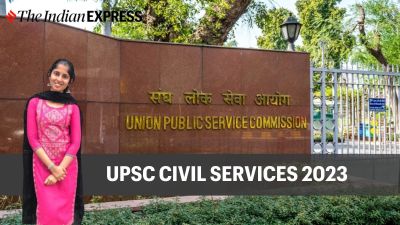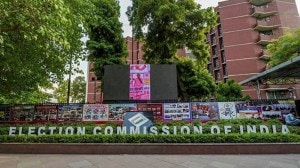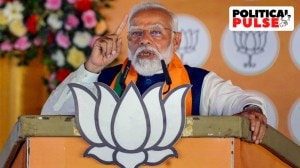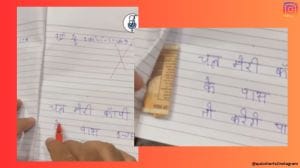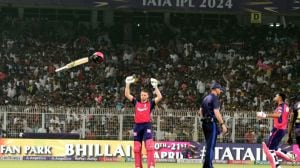- India
- International
Slum families in Delhi find new home — with power and water
Two months ago, Yadav, along with 55 other families, were moved to Dwarka, a subcity on Delhi’s southwestern fringe, some 30 km away from the high-security VIP zone. But they are not complaining.
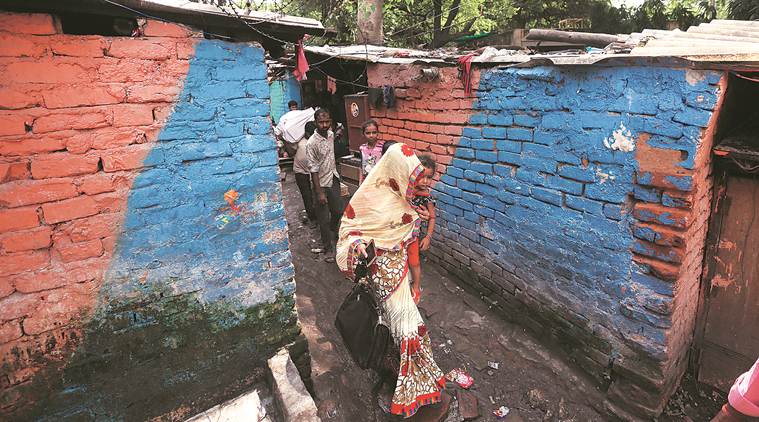 55 families have been shifted from a slum to an EWS housing complex. Gajendra Yadav
55 families have been shifted from a slum to an EWS housing complex. Gajendra Yadav
Until mid-September, Ram Kripal Yadav counted ministers, government officials, and judges among his neighbours in New Delhi’s Sunehri Bagh. India Gate, a 10-minute-walk away, was more of a colony park for him.
Two months ago, Yadav, along with 55 other families, were moved to Dwarka, a subcity on Delhi’s southwestern fringe, some 30 km away from the high-security VIP zone. But they are not complaining.
“Yahaan bijli ka meter lag gaya hai. Paani ka motor chaalu hai, aur gas line lagaa diya gaya hai. Saaf safai achchhi hai. Koi dikkat nahi hai yahaan.(Electricity meter has been installed, there is a motor for water, and piped gas. The surroundings are clean. There are no issues),” Yadav said.
The families of Yadav and the others now live in the EWS housing complex built by the Delhi Urban Shelter Improvement Board (DUSIB) under the Delhi government’s Mukhya Mantri Awas Yojana. Until September 16, they were residents of JJ Basti Dhobi Ghat, a slum comprising rows of fragile brick walls covered by tin sheets, standing around open gutters. This patch of urban squalor, home to 87 families, with no steady supplies of water and electricity, had stood in the middle of Lutyens’ Bungalow Zone for over four decades, next to what is now the official residence of former union minister Rajyavardhan Singh Rathore.
The scheme under which the families were relocated was notified in December 2017. Its beneficiaries told The Sunday Express that despite having to travel longer distances to work, they were happy with their significantly more dignified existence.

 The scheme under which the families were relocated was notified in December 2017.
The scheme under which the families were relocated was notified in December 2017.
“The relocation has had a transformative impact on our lives. But the only problem is the travel expenditure. Why do you think we stayed in such conditions in that slum for so many years?,” Yadav, who works as a labourer with a contractor at the Air Force headquarters, said.
Yadav and his wife Mithiliesh have a son, Rohit, who studies in Class IX. Yadav said he spends around Rs 30 per day commuting to work and back. “Rohit goes to an NDMC school in Aurangzeb Lane, but he has a student pass. Authorities had promised to assist us in getting admissions in local schools, but that can happen only next year,” Yadav said.
The Delhi government’s policy emphasises on in-situ rehabilitation, and allows relocation within a radius of 5 km. However, in “exceptional circumstances”, it allows for relocation farther away with prior approval of the DUSIB Board. The Sunehri Bagh relocation was cleared by the DUSIB Board on December 5, 2018.
Most of the Sunehri Bagh families paid Rs 1.12 lakh to get possession of the flats, along with a five-year maintenance charge of Rs 30,000. Those belonging to the Scheduled Castes paid around Rs 31,000 each.
On the day of the relocation, The Sunday Express had found the beneficiaries excited and anxious in equal parts about the move. Mithilesh had said she was happy about moving, but was sad, too. “I moved here after I got married 15 years ago. My son and two daughters were born here. You may see filth here, but there are memories,” she said.
Most of the families hail from Bihar’s Sitamarhi district, and are employed as labourers, painters, and carpenters by contractors who work in government offices and ministerial bungalows in the Lutyens’ Bungalow Zone. A few in the younger generation have managed to get jobs that are more managerial in nature. Hemant Kumar (22) is a personal aide to Rajya Sabha MP (nominated) Swapan Dasgupta, for example.
“I am happy that my family is moving to a better place. But today I can’t help but recall the days of my childhood. Bungalow number 12 came up only seven-eight years ago. Earlier we used to play there. Itna safe area kahaan milega? Saare VIPs ke beech,” Kumar had said then.
Not all the families in the slum have been able to move, though. On the day of the relocation, those who had been found ineligible stood helpless as workers deployed by DUSIB moved in with demolition equipment. The families were given a couple of days to vacate the area.
Among those left out was the family of Kudus (38). The certificate issued by the DUSIB to him said that the ration card he had produced to establish his eligibility had been found “cancelled”. Abdul Raqeeur, whose 12-year-old son M Dilwar Alam has a physical handicap, was also among those left out; so was Dasharath Rai.
They all stood clutching Aadhaar cards and voter IDs. Some had grievance letters carrying the stamp of the offices of Chief Minister Arvind Kejriwal, who is also the local MLA, and New Delhi MP Meenakshi Lekhi of the BJP.
According to a senior DUSIB official, the beneficiaries of the scheme have all cleared three conditions each.
“Firstly, a person’s name has to be there in the survey we carried out in this slum in 2016. Secondly, his or her name should be there in the voter lists of the years between 2012 and 2016. Thirdly, they have to possess any one of the 12 IDs mandated under the scheme. Voter IDs and Aadhaar cards, which were produced by most of those who were found ineligible, are not a part of that list,” the official said.
The new complex that luckier families have moved to is a cluster of 736 1-BHK EWS flats in Dwarka’s Sector 16 B, which came up in 2011 under the JNNURM.
Apr 16: Latest News
- 01
- 02
- 03
- 04
- 05











